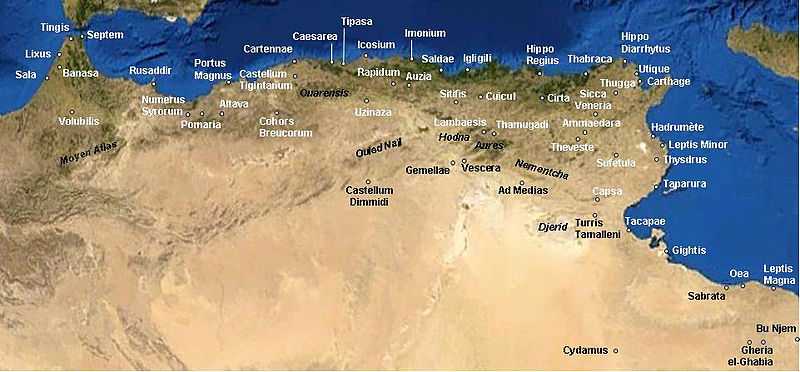Castellum Dimmidi


Castellum Dimmidi was a Roman settlement and fortification in southern Mauretania Caesariensis.[1] It is now called Messaâd in modern Algeria.
History
The area to the south of Mauretania Caesariensis has been settled since the Neolithic, as can be seen by the Rock art of the Djelfa region. The desertification process- which started after the Romans arrived there- was still not complete and there was a "chariot route" that crossed the Sahara between the eastern Atlas Mountains and Sub-Saharan Africa.[2]
Romans during the reign of Septimius Severus controlled the Trans-Saharan trade (even introducing the camel to the area) between the rich Africa Proconsularis and the Ahaggar Mountains/Niger River and created fortifications in the limes of the desert in order to defend it. One of these castra was "Castellum Dimmidi", that protected the trade routes and defended against raids from nomadic tribes.
Castellum Dimmidi was located about 180 miles south of Icosium (now Algiers), just on the fringes of the Sahara desert. During the Roman period, it was known by this name after the Romans under emperor Septimius Severus seized the settlement. It is unclear if the second part of the name, Dimmidi, was a native name transliterated into Latin, or a new name given by the Romans.
As the term Castellum (castle in English) implies, the settlement was a fortress along the Roman limes, that stretched from the Limes Tripolitanus to the southern border of the provinces of Mauretania Caesariensis and Numidia. It was a prosperous village and hosted a Roman garrison from roughly 198 to 240 AD.
The Roman occupation did not extend much to the S of the "Chott el Hodna", in the direction of the Ouled Naïl and the Djebel Amour.....Detachments of the Third Augustan Legion and of auxiliaries had then reached the heart of the Djebel Amour. But the permanent post farthest south known at present is "Castellum Dimmidi", on the wadi Messad. In 198 the legate propraetor of the Third Legion had sent legionaries there, supported by Pannonian cavalry and under the command of Flavius Superus. The installation of a permanent camp undoubtedly dates to that time. The camp was maintained until about 238 AD, the date of the temporary disbanding of the Third Legion. Excavations have revealed a part of the rampart which protected the soldiers' quarters. The wall was irregular in plan. Today very little can be seen on the site since the excavations were not continued and no attempt was made to consolidate the remains. The inscriptions also have almost all disappeared. They have been published and permit the reconstruction of certain aspects of the life of the camp. About 100 men relieved one another there; they were legionaries and later, after Alexander Severus, Palmyrans.The inscriptions and the paintings (now deposited at the Algiers Museum) give an idea of the soldiers' religious life as it pertained to official and Palmyrene cults.' '-Gilbert Charles Picard [3]
The small settlement had a "Roman Forum" surrounded by walls two meters in height. Initially, it was occupied by legionaries of the Legio III Augusta from Lambaesis, but during the reign of Septimius Severus, the castrum was defended by the equites (cavalry) of Numerus Palmyrenorum from Roman Syria.[4] The castrum was probably built and enlarged by a "vexillation" of Legio III Augusta and the "Ala I Pannorum", according to the historian Lawless.[5] Castellum Dimmidi was connected to a small Roman fortification further south at Laghouat.
The Roman presence in Castellum Dimmidi lasted only 50 years, but left a vicus (small village) inhabited by Berbers who were later converted to Christianity[6]
Notes
- ↑ Detailed map of Mauretania Caesariensis showing Castellum Dimmidi
- ↑ P. Masonen: Trans-Saharan Trade
- ↑ Picard, Gilbert. "Castellum Dimmidi" Princeton, 1944
- ↑ Castellum Dimmidi (in Italian)
- ↑ Lawless: Mauretania Caesariensis, Roman fortifications
- ↑ Persee: Castellum Dimmidi (in French)
Bibliography
- Grimal, P. Castellum Dimmidi, in "Revue des Études Anciennes", LI, 1949, pp. 177–179
- Huard P. et Allard L. Les Figurations rupestres de la région de Djelfa, Sud Algérois, dans Lybica, Centre de recherches anthropologiques, préhistoriques et ethnographiques - Algiers. vol XXIV. Algiers, 1976
- Sabour and Vikør. Ethnic encounter and culture change. Section of Masonen on Transaharan Trade. Bergen/London 1997 (p. 116-42).
See also
- Mauretania Caesariensis
- Caesarea
- Auzia
- Altava
- Albulae
- Rapidum
- Numerus Syrorum
- Cirta
- Thamugadi
- Lambaesis
- Roman 'Coloniae' in Berber Africa
- Christian Berbers
%2C_Algeria_04966r.jpg)